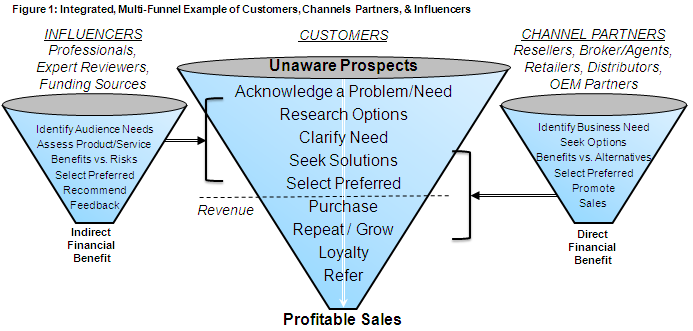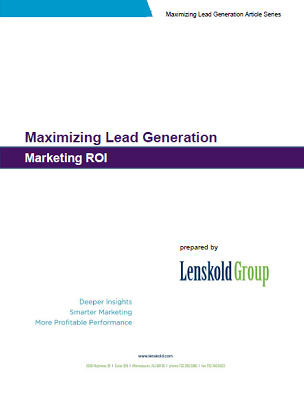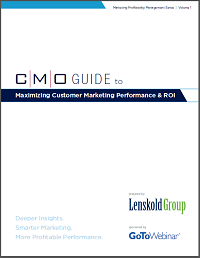Lenskold Article Series
by Jim Lenskold
Marketing to Customers, Channel Partners, & Influencers – How to Manage Multi-Funnel Complexity
Many companies need to win more than just the support of the customers to generate sales. Some companies sell or distribute their products/services through independent channel partners, such as brokers, resellers, distributors, or retailers. In addition, some companies are dependent on strong influencers, such as professionals compensated for their recommendations, expert reviewers, or independent funding sources who are paying for all or part of the purchase. Weakness in any one area can be detrimental to overall sales despite showing strengths with one particular target group. So where and how do you most effectively invest your marketing budget across these separate targets to successfully generate sales?
This is where the funnel approach becomes even more important and works best when established to manage multiple funnels as a single, integrated approach to driving new sales. These decision funnels will include the stages each target must pass through to purchase, sell/distribute, or recommend. Stages that include awareness, needs definition, consideration, engagement, preference, and action (much more detailed for actual use) represent what marketing must influence and where customers may “leak” if they fail to reach the desired outcome.
Managing multiple funnels can simplify these complex business models and help you 1) understand how decision funnels for target groups relate to one another, 2) identify where and how your marketing impacts funnel progression and leakage for each target, and 3) quantify both plans and performance evaluation to improve ROI.
Creating a Multiple Funnel Framework
While marketers using the funnel typically define the funnel stages from the company perspective, the funnel becomes much more strategic and actionable when defined from the customer perspective. Figure 1 shows high level funnel stages for each target group and an example of how they might relate to one another.
Influencer Impact
Influencers can play a significant role as customers reach the stage of researching and evaluating their options to address a need or problem. When influencers are recommending alternatives to your products/services, they create leakage points where customers decrease their consideration and purchase intention. When your marketing effectively wins greater support from more influencers, the impact will show an increase in these early evaluation stages of the customer purchase funnel.
Channel Partner Impact
Similarly, marketing to expand your channel partner penetration or increase the performance of existing channel partners selling or distributing your products/services ultimate impacts many areas of your customer funnel. The impact can shift perceptions and actions with the most important being a lift in sales conversions. Marketing organizations sometimes miss the opportunity to get better returns from investments to improve the effectiveness of their channel partners over investments into additional branding or demand generation.
Customer Impact
Customers typically drive the ultimate purchase decision, although channel partners and influencers can initiate the purchase direction or create significant purchase barriers. Marketing direct to the customer when strong channel partner or influencer relationships are present is likely to have an impact on the decision funnels of these other target groups as well. Marketing efforts may be directed at creating strong brands and high demand among customers that will increase performance from channel partners and win support from influencers. Or marketing strength with consumers can create enough demand to generate sales with limited channel and influencer support. This pull-through strategy can impact the customers’ choice of channel partners (such as the iPhone’s influence on AT&T sales) or impact the influencers’ decisions (such as a physician’s willingness to prescribe a specific brand based on a patient’s preference).

Developing a more detailed version of this multi-funnel for your own business model provides clarity for assessing different strategic approaches to grow sales. Your assessment of the primary areas of funnel leakage, with either detailed quantitative analysis or general qualitative input from sales and marketing teams, will lead you to opportunities to improve effectiveness and ROI. While companies often debate whether they need a push or pull strategy, the best opportunity for improving performance will come from identifying the weak areas within the combined funnel.
Following are examples of leakage points that marketing can influence…
For Channel Partners:
- More likely to recommend competitive products/services
- Not promoting your products/services
- Promoting your products/services but ineffective at converting buyers
For Customers:
- No brand awareness, consideration, or preference for your products/services
- Not responding to channel partner promotions
- Prefer other channel partners that do not sell your products/services
- Responding to influencer input with decreased preference and purchases
For Influencers:
- No brand awareness, consideration, or preference for your products/services
- More likely to recommend competitive products/services
- Lack of access for influencers supporting your products/services to reach customers and channel partners at the right time in their decision process
Guiding Strategies and Tactical Planning
Once you have created your integrated, multiple funnel framework, you can then put it to use to guide strategies within or across the multiple target groups with a better sense of the impact on all target groups as well as the connection to incremental sales.
- Formulate your marketing strategy within or across target groups.
- Identify the tactics and the initial outcomes in terms of influencing funnel progression for the specific target group contacted.
- Identify secondary outcomes in terms of funnel progression on the other non-contacted target groups.
- Map out how the expected initial and secondary impact is intended to lead to an increase in sales to customers.
- Use the expected impact on specific areas of the multiple funnels to guide key metrics, implement tracking, and define measurements of marketing effectiveness.
- Measure new marketing initiatives and/or test alternatives to determine the actual impact relative to expectations. Measurements should concentrate on targeting and funnel leakage where improvements are likely to have the most significant value.
Pharmaceutical Marketing Example
Pharmaceutical companies have a very unique requirement for their multi-funnel environment with two very strong influencer groups in addition to the consumer; healthcare practitioners who write prescriptions (such as physicians) and insurance companies (a.k.a. “payers”) who fund all or part of the expense for consumers. There are marketing and sales efforts to all of the target groups. Practitioners have the potential to drive sales volume even without consumer marketing, and, along with insurance companies, can create significant funnel leakage even when consumer demand is high. Leakage results when practitioners have strong objections to the product or when the lack of funding from payers leads to competitive replacement.
Here is a brief example of how the initial and secondary outcomes guide the primary metrics to track and measure.
Initial Outcome |
Secondary Outcome |
Primary Metrics |
|
Practitioner marketing (influencers as professionals)Decision based on assessment of quality of healthcare and impact on patient satisfaction |
Increase recommendations | Increase prescriptions with consumer acceptance and payer approval Increase payer conversion with increased demand (payer risks losing enrollment from consumers and employers) | Increase in recommendations Increase in prescriptions |
Insurance Company marketing (influencers as payers/funding source)Decisions with long-term impact based on cost control and offering attractive coverage |
Increase prescriptions with consumer acceptance and physician support | Increase in physician recommendations | Increase in prescriptions Increase in quantity of insurance companies offering coverage |
Consumers (customer decision-makers)Decision based on health benefits and personal cost |
Increased brand preference Increased requests to physicians | Increase prescriptions with physician support and payer approval | Increase in recommendations Increase in prescriptions |
Allocating Budget to Multiple Target Groups
One of the greatest barriers to choosing the best marketing investments is an organizational structure that separates marketing teams into silos which each concentrate on the different target groups. Not only does this make it difficult to integrate marketing initiatives, but it also tends to limit measurement of the marketing impact to just the group targeted so the opportunity to create higher impact campaigns influencing multiple target groups gets missed. In addition, the organizational structure can lead to competition for budgets that may compromise the decisions to manage toward a greater collective impact.
There are many levers that marketing can use to improve bottom line results, such as:
- Invest in brand to influence customers, channel partners, and influencers
- Motivate channel partners through their decision funnel to either expand the number of partners or grow your share of existing partners
- Improve the marketing and sales effectiveness of channel partners to increase sales with customers and increase channel partner preference/loyalty
- Motivate influencers through their decision funnel to either increase the number of influencers, increase the strength of recommendations, or increase the frequency of positive mentions
- Connect customers in early stages of the purchase funnel to positive influencers to increase the portion of customers progressing to a purchase decision
- Improve the customer experience with your products/services to increase repeat purchasing from customers, increase channel partner benefits, and win more support from influencers
Here are several options for evaluating where to invest marketing based on effectiveness and profit contribution, ranging from basic to more sophisticated:
- Measure the effectiveness of existing marketing on the initial outcome (i.e., the primary objective) and incremental sales
- Test new strategies to determine how to best improve marketing effectiveness
- Assess funnel leakage independent of marketing campaigns to prioritize the need for new or improved marketing based on profit potential
- Run analytics to understand the affect of improvements within one target group on other target groups (such as the marketing impact on influencer outcomes having a subsequent impact on channel partner decisions)
- Model the impact of specific tactics on multiple target group funnels (such as the consumer advertising impact on influencer and channel partner perceptions and actions)
Companies in the high-tech, financial services, insurance, pharmaceutical, automotive, and dozens of other industries are dependent on winning the support and influencing the decisions of multiple target groups in order to successfully generate sales. Each target group has their own decision funnel that can benefit from marketing support. With limited marketing budgets, marketing executives can use integrated multiple funnels as a smarter approach to guide strategies, measurements, and improvements to performance and profitability.







